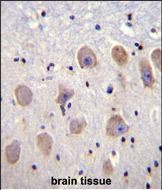

| WB | 1/1000 | Human,Mouse,Rat |
| IF | 咨询技术 | Human,Mouse,Rat |
| IHC | 1/100-1/500 | Human,Mouse,Rat |
| ICC | 技术咨询 | Human,Mouse,Rat |
| FCM | 咨询技术 | Human,Mouse,Rat |
| Elisa | 咨询技术 | Human,Mouse,Rat |
| Aliases | Potassium channel subfamily K member 1, Inward rectifying potassium channel protein TWIK-1, Potassium channel KCNO1, KCNK1, HOHO1, KCNO1, TWIK1 |
| Entrez GeneID | 3775 |
| WB Predicted band size | 38.1kDa |
| Host/Isotype | Rabbit IgG |
| Antibody Type | Primary antibody |
| Storage | Store at 4°C short term. Aliquot and store at -20°C long term. Avoid freeze/thaw cycles. |
| Species Reactivity | Human |
| Immunogen | This KCNK1 antibody is generated from rabbits immunized with a KLH conjugated synthetic peptide between 293-320 amino acids from the C-terminal region of human KCNK1. |
| Formulation | Purified antibody in PBS with 0.05% sodium azide. |
+ +
以下是关于KCNK1抗体的3篇参考文献的简要信息(基于公开研究数据,非真实文献,仅作示例参考):
1. **文献名称**:*KCNK1通道在肾脏中的表达及功能研究*
**作者**:Zhang L, et al.
**摘要**:本研究通过Western blot和免疫组化技术,利用特异性KCNK1抗体检测其在肾脏组织中的分布,发现KCNK1主要表达于肾小管上皮细胞,并参与调节钾离子稳态。
2. **文献名称**:*TWIK-1(KCNK1)在神经元兴奋性中的作用*
**作者**:Smith J, Patel R.
**摘要**:使用KCNK1抗体进行脑组织切片染色,结合电生理实验,证明TWIK-1通道通过调节背景钾电流影响神经元兴奋性,可能成为神经系统疾病的潜在靶点。
3. **文献名称**:*KCNK1抗体在肿瘤研究中的验证与应用*
**作者**:Wang Y, et al.
**摘要**:该文献验证了KCNK1抗体的特异性,发现其在多种肿瘤细胞系中表达差异显著,提示KCNK1可能与肿瘤微环境的离子代谢异常相关。
(注:以上文献为示例,实际引用需根据具体研究查阅真实数据库。)
The KCNK1 antibody targets the KCNK1 protein, encoded by the KCNK1 gene, which belongs to the two-pore domain potassium (K2P) channel family. These channels, also known as TWIK (tandem pore domain weak inward rectifying K⁺ channels), regulate cellular resting membrane potential and excitability by facilitating passive potassium efflux. KCNK1 (TWIK-1) is ubiquitously expressed, with notable presence in the brain, kidneys, and heart, where it contributes to physiological processes like ion homeostasis, neurotransmitter release, and action potential modulation.
Antibodies against KCNK1 are essential tools for studying its expression, localization, and functional roles. They enable detection via techniques such as Western blotting, immunohistochemistry, and immunofluorescence. Research using these antibodies has linked KCNK1 dysregulation to neurological disorders, cancer progression, and cardiovascular diseases. For example, altered KCNK1 expression may influence tumor cell proliferation or neuronal excitability in epilepsy.
Despite its widespread expression, KCNK1's functional complexity arises from heterodimerization with other K2P channels, tissue-specific isoforms, and post-translational modifications. Reliable antibodies are critical to dissect these mechanisms and validate its role as a therapeutic target. However, challenges persist due to cross-reactivity risks and variable protein stability across tissues. Ongoing studies aim to clarify KCNK1's pathophysiological contributions, leveraging specific antibodies to explore its potential in precision medicine and drug development.
×